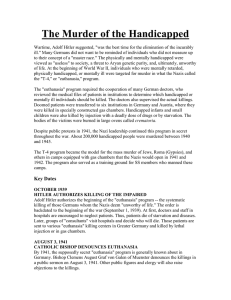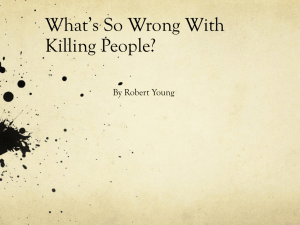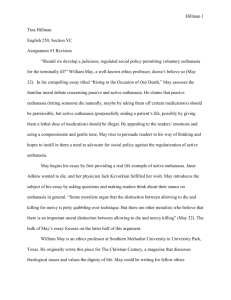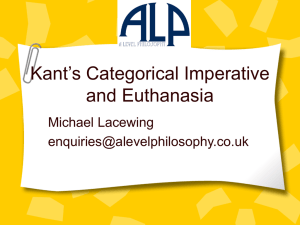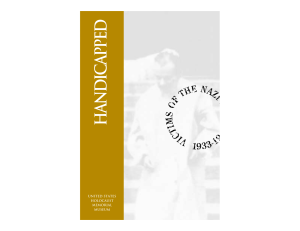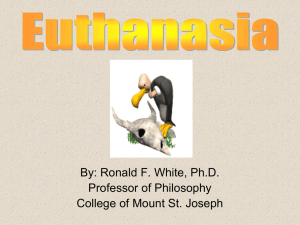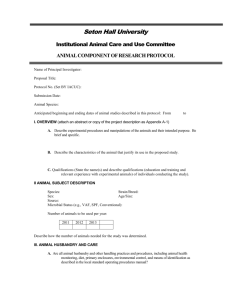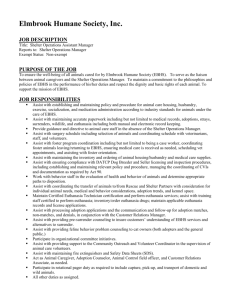Killing While Caring - Medicine After The Holocaust
advertisement
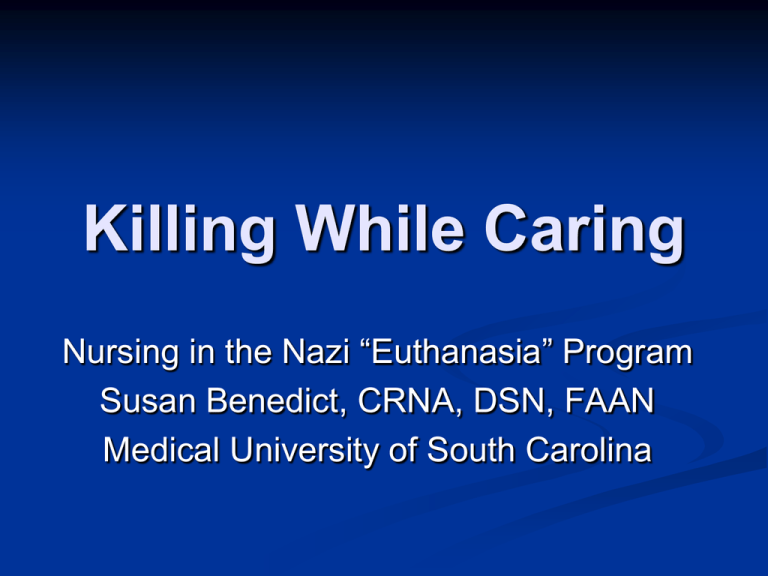
Killing While Caring Nursing in the Nazi “Euthanasia” Program Susan Benedict, CRNA, DSN, FAAN Medical University of South Carolina First, the language of disability: People with disabilities… People with developmental disabilities… Many terms used are those of the time and are not acceptable today. “A history of mental illness”… as non-specific as “a history of physical illness”. is Anna G: Accused of killing 150 patients… “When giving the [lethal] medicine, I proceeded with a lot of compassion. I took them lovingly and stroked them when I gave the medicine. They were not to be tortured more than necessary.” Steps to the “Final Solution” Devaluation and generalization Sterilization Euthanasia Concentration camps How could this happen? Eugenics Passed in 1922, the US Model Eugenical Sterilization Law applied to Feeble-minded Insane (including the psychopathic) Criminalistic (including the delinquent and wayward) Epileptic Inebriate (including drug users) Diseased (including the tuberculosis, the syphilitic, the leprous, and others with chronic, infections, and legally segregable diseases Blind (including those with seriously impaired vision) Deformed (including the crippled) Dependent (including orphans, ne’er-do-wells, the homeless, tramps and paupers. Eugenics also popular in US Courses taught at Columbia University Brown University Northwestern University Harvard University Cornell University University of Wisconsin In 1925, in “Mein Kampf” Hitler wrote… “Those who are physically and mentally unhealthy and unworthy must not perpetuate their suffering in the body of their children.” July 1933: Germany’s sterilization law passed Hereditary epilepsy Schizophrenia Mental deficiency Huntington’s chorea Hereditary blindness and deafness Certain malformations Severe alcoholism 1934 - 1939 More than 350,000 people were sterilized in Germany Education Examples in textbooks Courses in nursing and medical schools Racial hygiene a component of all education 1935 Textbook Problem 95 The construction of an insane asylum requires 6 million RM. How many housing units @ 15,000 RM could be built for the amount spent on insane asylums? Socialization Posters depicting people with handicaps Movies Sterilizaton to “Euthanasia” Binding and Hoche, 1920: The right to live must be earned. Destroying “lives not worth living” would be humane. Elimination not a crime but permissible and beneficial Applied to People with terminal illnesses “Incurable lunatics” Those who had sustained an illness or injury and would awaken to a “nameless misery” Three phases of killing The children’s “euthanasia” program The T4 “euthanasia program “Wild euthanasia” The Children’s “euthanasia” program – 1945 5,000 – 7,000 children killed 1939 All children with the following had to be reported: Idiocy and Mongolism (particularly if blindness or deafness were also present Microcephalie [sic] Hydrocephalus Deformities of every kind, in particular the absence of limbs, spina bifida, etc. Paralysis including Little’s disease (Spastics) The midwife Received a fee of 2 Reichsmark “in return for her trouble” 3,000 – 5,000 children were murdered T-4 “Euthanasia” Program Grafeneck Brandenburg Hartheim Sonnenstein Bernburg Hadamar T-4 “Euthanasia” Program Began with this letter: 1 September 1939 Reichleiter Bouhler and Dr. med Brandt are charged with the responsibility to extend the authorization of certain physicians designated by name in order that patients who must be considered incurable on the basis of human judgment be granted the mercy death after a critical evaluation of their illness. Adolf Hitler The plan to kill 60,000 70,000 The victims of T-4 Persons with developmental disabilities Psychiatric patients Epileptics Persons with inherited diseases or conditions Persons with family histories of disease, alcoholism, antisocial behaviors Hadamar 14f13 T4 ended August 1941 Killings had become public knowledge Churches objected No objections from nursing or medical organizations 70,273 adults were killed in the T4 program “Wild euthanasia” Roles of nurses in the “euthanasia” programs Reported newborns and children with disabilities Selected patients for killing Accompanied the transports Killed patients Aktion Reinhard Consequences for the nurses Why did nurses participate? Belief in National Socialism and its goals: “I swear to Adolf Hitler, my Führer [leader], unswerving loyalty and obedience. I commit myself to every assignment that I am placed in and to fulfill my task as a National Socialistic nurse, loyal and conscientious in the service for the people, so help me God.” Obedience To government To administrators To physicians To superior ranking nurses Lack of support From colleagues From professional organizations Duress? Some were sworn to secrecy. Some were threatened verbally. In over 50 years of post-war testimony, no instance has been found of anyone being shot, harmed, or sent to a concentration camp for refusing. Economics Housing was tied to the job. Jobs were hard to find. Bonuses were paid for working in the killing units. In their words: Helene W. (killed several hundred): “I only did my duty, and I did everything on the order of my superiors. Luise E. (210) “I would consider it a release if a physician or a person acting on direction of a physician would give me a dose releasing me from my suffering…I didn’t do it with a light heart but only after serious inner fights I obeyed the orders.” Anna G.: (150) “I would never have committed a theft because I know one isn’t allowed to.” Martha W. (150): “The only explanation I can give is that I didn’t have enough time to think about it at that time because the nurses were put under a lot of stress.” Erna D.: “I can’t say why I didn’t refuse.” Margarete T. (150): “I saw the act of giving medicine, even in order to kill mentally handicapped persons, as an obligation I wasn’t allowed to refuse. In case of refusal, I always imagined my dismissal from the job of nurse and civil servant, which is why I didn’t refuse.” Meta P. “Among the nurses, there was strict discipline and every subordinate nurse was obliged to strictly execute the orders of the superior.” Edith B.: “I didn’t see anything wrong with it.” Margarete Maria M.: “If I had refused to execute her [another nurse’s] orders, I would have been dismissed. I could have quit the job, but at that time I was obliged to support my grandparents in Mesertiz.” Gertrude F.: “I was the youngest nurse on our ward. Still today, I haven’t completely become aware of my wrongdoing.” The killings of the “euthanasia” programs led to the murders in the concentration camps. Lessons for today: Remember the victims. Be vigilant against marginalization. Avoid generalizations about groups; i.e., the “mentally ill”, the “disabled”. Consider the “slippery slope” of assisted suicide and euthanasia.



